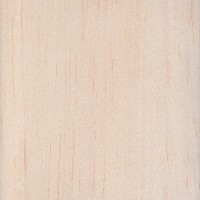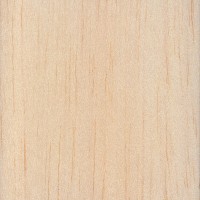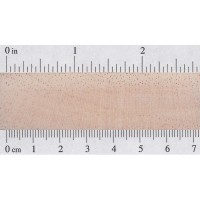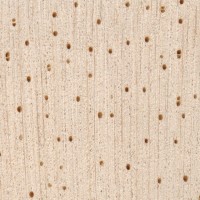 |
Common Name(s): Balsa Scientific Name: Ochroma pyramidale Distribution: Tropical regions of the Americas; also grown on plantations Tree Size: 60-90 ft (18-28 m) tall, 3-4 ft (1-1.2 m) trunk diameter Average Dried Weight: 9 lbs/ft3 (150 kg/m3) Specific Gravity (Basic, 12% MC): .12, .15 Janka Hardness: 67 lbf (300 N) Modulus of Rupture: 2,840 lbf/in2 (19.6 MPa) Elastic Modulus: 538,000 lbf/in2 (3.71 GPa) Crushing Strength: 1,690 lbf/in2 (11.6 MPa) Shrinkage: Radial: 2.3%, Tangential: 6.0%, Volumetric: 8.5%, T/R Ratio: 2.6 |
Color/Appearance: Heartwood tends to be a pale reddish brown color, though it is not commonly seen in commercial lumber. Most boards/blocks of Balsa are from the sapwood, which is a white to off-white or tan color, sometimes with a pink or yellow hue.
Grain/Texture: Balsa has a straight grain with a medium to coarse texture and low natural luster.
Endgrain: Diffuse-porous; large pores in no specific arrangement; solitary and radial multiples of 2-3; growth rings indistinct; rays visible without lens; parenchyma typically not visible with lens.
Rot Resistance: Sapwood is rated as perishable, and is also susceptible to insect attack.
Workability: Generally very easy to work with virtually no dulling effect on cutters; yet because of its extremely low density, fuzzy surfaces can be a problem when using dull cutters. Balsa generally should not be used to hold nails, with glue being the preferred method of joining. Balsa stains and finishes well, though it has a tendency to soak up large quantities of material on the initial coats.
Odor: No characteristic odor.
Allergies/Toxicity: Although severe reactions are quite uncommon, Balsa has been reported to cause skin irritation. See the articles Wood Allergies and Toxicity and Wood Dust Safety for more information.
Pricing/Availability: High quality Balsa (that is, Balsa with a very low density) can be rather expensive when purchased at hobby stores or other specialty outlets. Larger boards and lumber sold through typical hardwood dealers is hard to find, but generally has a better cost per board-foot than other sources.
Sustainability: This wood species is not listed in the CITES Appendices or on the IUCN Red List of Threatened Species.
Common Uses: Buoys, rafts, surfboards, model airplanes, musical instruments, packing/transport cases, core stock in sandwich laminations, and fishing lures.
Comments: Balsa is a wood that is famous worldwide. And while its density and mechanical values can vary significantly depending on the growing conditions of any particular tree, it is generally the lightest and softest of all commercial woods, ranging from 8 to 14 pounds per cubic foot. Yet despite its softness, Balsa is technically classified as a hardwood, rather than a softwood, since it has broad leaves and is not a conifer.
Balsa has excellent sound, heat, and vibration insulating properties, and is also incredibly buoyant: in fact, “Balsa” is the Spanish word for “raft.”
None available.
Scans/Pictures: A special thanks to Steve Earis for providing the wood sample for this wood species.








Historical Society I belong to obtained historically significant pair of skis – appx 130+ years old. Wondering if there’s an oil to condition/preserve them to use? Thank you.
PAULOWNIA WOOD
Paulownia has been thoroughly tested and found to have a higher strength to weight ratio than Balsa!
Auburn University tested the strength of 18 lb p/cubic ft. Paulownia against Balsa, with an average weight of 10 lbs p/cubic foot.
https://drive.google.com/file/d/17XKHvjwVq5jCpDoS7fKRG5tgADbi8z7i/view?usp=sharing
Does anyone know how common balsa trees are in South America? For example would 5 out of 100 trees in a rainforest be balsa or something like that?
Typically 2 or 3 balsa trees per hectare of natural SA rain forest, whereas plantations easily manage 1,000 balsa trees/hectare in a monoculture with less than 10 years planting to harvest. 60% + (volume wise) of balsa in commerce is plantation grown as of 2023.
Does balsa wood have varying hardnesses? I watched a video from the Rapala company in finland . They said their balsa had different hardnesses. John
Yes, there is a wide variation in balsa hardness. Most of the stuff in hobby stores for model airplanes and the like tends to be the very softest pieces.
hello!
Who is the author of this article and when was it published? thank you
Eric Meier, first published April 9, 2009
but is balsa isotropic? Why I can find only one Elastic modulus? Is this longitudinal or transversal?
No, it is not isotropic. MOE is almost universally listed as longitudinal value unless otherwise noted in literature.
hey how can i find price per weight i’m doing a school project and my teacher says we have to find price based on weight
anyone know the bulk modulus????
plz help
Dhyana, you can find that information on this same site. It is about the Paulownia tomentosa. There are several other variant species but the most common are the Paulownia Elongata, Paulownia Fortunata, besides the Tormentosa. I do not have yet the technical information about the Elongata and Fortunata, Common Name(s): Paulownia, Royal Paulownia, Princess Tree, Kiri Scientific Name: Paulownia tomentosa Distribution: Native to eastern Asia; also planted in eastern North America Tree Size: 30-65 ft (10-20 m) tall, 2-4 ft (.6-1.2 m) trunk diameter Average Dried Weight: 18 lbs/ft3 (280 kg/m3) Specific Gravity (Basic, 12% MC): .25, .28 Janka Hardness: 300 lbf (1,330 N) Modulus of Rupture: 5,480 lbf/in2 (37.8 MPa)… Read more »
They also use it in wind turbine blades
Is Balsa wood good for making gliders?
Yes, balsa was chiefly used as the material for small toy gliders and model crafting, including planes.
Balsa wood is a crappy wood that has virtyally no resistance. You have to soak it in epoxy for any kind of durability. Is just overhyped
I’m sorry, but that’s just ignorant. Bala is an amazing wood for the right application. It’s unmatched for model airplanes (also used in ful scale airplanes to some extent!) in terms of lightness and workability. You shoudn’t say it’s crappy just because you don’t know what to use it for.
No, I am saying it is crappy because if you try to fly those model planes they will break to pieces from wind. There are plenty of wood essences much better from the POV of durability and just as light. I do not need a paper mache model airplane that can break from wind. I should be able to use any model I make. For instance telia wood is light easy to work with and much more resistant.
Balsa isn’t very strong, but its low density makes it an excellent core material for composite structures. Balsa has been the standard material for model aircraft for decades. Plastic foam materials offer better crash-resistance, but balsa is still used as a laminate core material in many high performance designs. The de Havilland Mosquito was built with balsa-cored plywood and proved to be one of the most vital combat aircraft of the Second World War. Many yachts are built with a balsa-cored fiberglass hull, which provides excellent strength and good thermal insulation. Balsa is used as a core material in many… Read more »
Not too many things fall out of the sky unscathed. As far as the wind breaking models to pieces, construction is rated, windspeed has a cap, even before flight, and there is always pilot error.
does balsa grows on southern asia too?
I’m trying to build a structure for a competition and this is my first time reading anything like this- so hard!
thank u so much I wanted to do research on balsa wood for my woodwork class and I have thanx to u
how about Tensile strength?
I am looking for information about Palochina wood: dried weight,hardness…any
Thanks